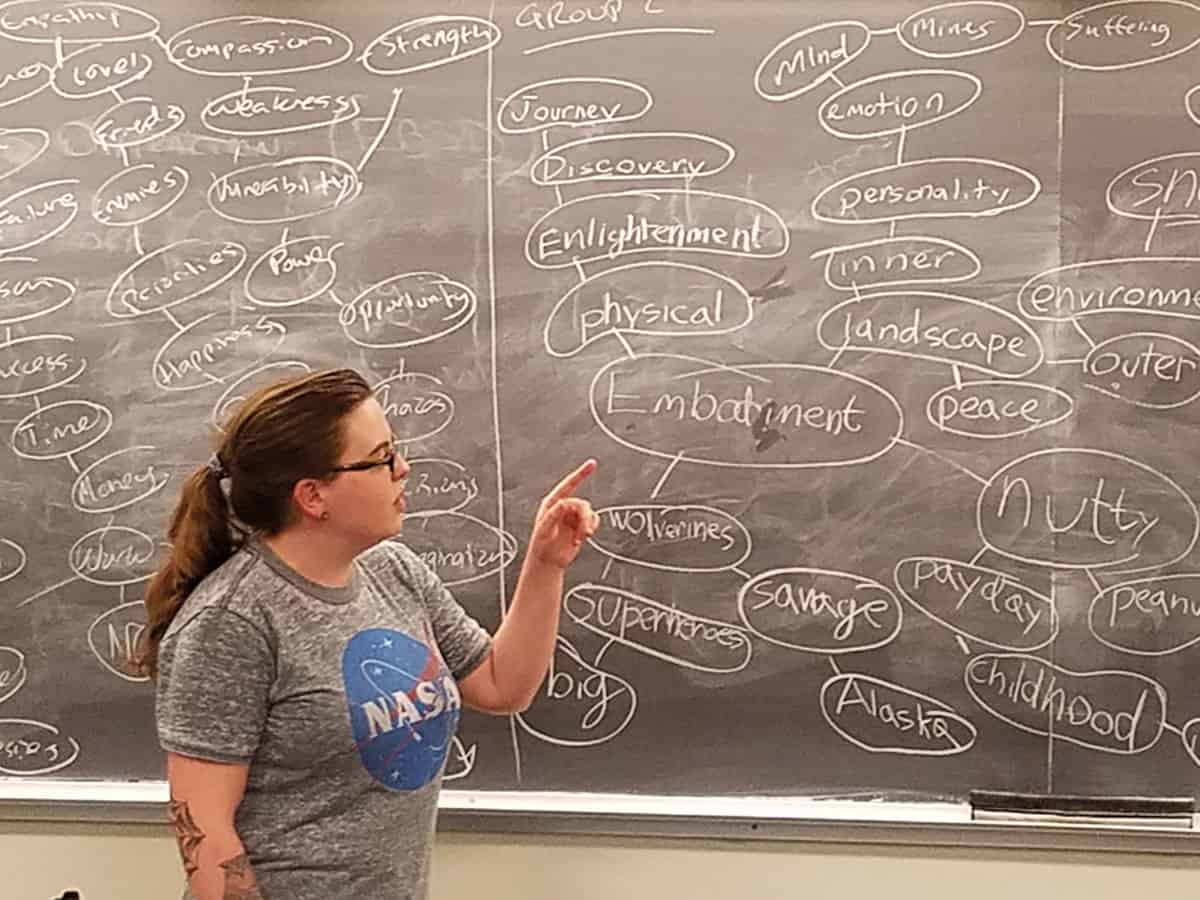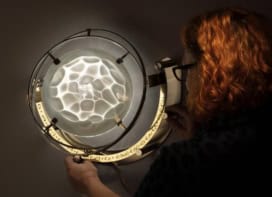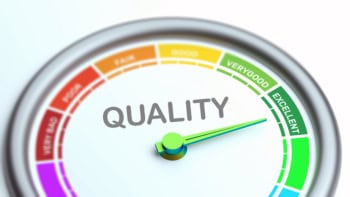We’re often taught to think of science and the humanities as discrete fields, with the former full of definite truths and the latter open to interpretation. But is that really the case? Lincoln Carr explains how he’s helping science students use the ambiguity essential to the humanities to become better researchers
How did I, a professor of theoretical physics, end up standing on one leg and eating a strawberry, while holding a bottle of vanilla to my nose? Oh, and with a dozen people watching me listen to a PowerPoint presentation on how my phone obsession was the first step toward becoming a cyborg.
Perhaps the journey to this point started when I was a graduate student and having troubles with my then-girlfriend. I thought just stating “the facts” about our relationship would surely fix everything. That did not go well.
Or maybe it began with politics. It had been bothering me for a long time that no matter how much slam-dunk data scientists showed about climate change, humanity wouldn’t stop burning fossil fuels. Should we scientists just give up and stew in our frustration? Or could there be another approach?
But I think the real impetus was my academic adviser. I desperately wanted him to believe in me. I spent three years trying to convince him that my doctoral research on solitons and vortices in Bose–Einstein condensates was more than pretty maths. I’d write out these beautiful derivations but he’d just shake his head and say, “Where’s the physics, Lincoln? What is this telling me?”
But what is “the physics”? Is it the data? Is it the story? Was it my adviser’s belief in me? After all, I had laid out the proof right in front of him, hadn’t I? Why was my truth falling short?
Facts, as it turns out, are not self-explanatory. Science is much more ambiguous than I had once naively imagined. When I was a student, courses mainly taught me to find solutions to well-posed problems with known answers. But how do we get from rigid curricula and textbook problems to research and the unknown? Physics is not maths – proofs are few and far between. Research requires embracing ambiguity. And one way to do this is to study the humanities and the arts, however surprising or counter-intuitive that might seem.

A history of ambiguity
The humanities have faced ambiguity for thousands of years. Even the very first written story – The Epic of Gilgamesh from ancient Sumeria – is open to more than one interpretation. Dating to around 2100 BC, the poem tells the story of King Gilgamesh of Uruk, whose people both adored him for leading their civilization and feared his power and capriciousness. One day an indigenous man, Enkidu – a great dreamer who ran naked with the animals – came to Uruk. Gilgamesh grew jealous of his people’s praise of the stranger. In a rage, he attacked Enkidu, and they fought to a stalemate. As Herbert Mason’s verse translation of the poem reveals, Gilgamesh then turned to Enkidu, who leaned against his shoulder, looked into his eyes:
“And saw himself in the other, just as Enkidu saw
Himself in Gilgamesh.
In the silence of the people they began to laugh
And clutched each other in their breathless exaltation.”
The Epic of Gilgamesh is a rich and complex story. In part it is a surprisingly modern metaphor for how so many of us feel nostalgia for a simpler life, as the people of Uruk admired Enkidu’s idyllic lifestyle. It could also be interpreted as the relationship between science (Gilgamesh) and humanities (Enkidu), and how they find themselves reflected in each other. An even more powerful message presents itself in the sudden empathy between the two combatants, who form one of the greatest friendships in history.
The humanities teach us ambiguity, but above all they teach us how to be human. Mary Oliver, a Pulitzer prize-winning poet I adore, died earlier this year. Over and over again she draws me into nature, its terror and beauty and peacefulness. And what is physics but the Greek word physike, meaning nature? In her poem “Sometimes” she writes:
“Instructions for living a life:
Pay attention.
Be astonished.
Tell about it.”
Could there be a more concise, perfectly stated description of the life and duty of a scientist? This is how poets and scientists alike practise their crafts. We have much in common.
Many of the cognitive tools developed in the humanities are thousands of years old. Science is much, much younger. In fact, the physical sciences were an integral part of the historical liberal arts. It is thus natural that many great scientists, past and present, were also students of philosophy and literature. Take Hasan Ibn Al-Haytham, who died a thousand years ago. He was educated in traditional Muslim philosophy and, through experiments on human perception, was able to adapt an artistic instrument – the camera obscura – to observe a solar eclipse. In one fell swoop, this philosopher founded the field of optics and invented the scientific method. Seven hundred years later, Gottfried Wilhelm Leibniz, whose notation for calculus we still use today, produced equally famous works in philosophy, ethics and linguistics. His impact in the humanities was nearly as great as his work in mathematics, physics, technology and early computer science.
In the present era, Harvard chemist and physicist Eric Heller’s plots of quantum chaotic wavefunctions adorn the walls of the US National Science Foundation, where each day scientists find inspiration. In my UK collaboration, Quantum Science with Ultracold Molecules, our artist in residence Geraldine Cox closed our meeting last summer with a seminar on her artistic interpretation of our work. Cox also leads our programme that teaches about the atom and our place in the universe to eight-year-old children and their families. “Atoms are like tiny musical instruments playing notes we can see,” she said. Afterward I heard a highly accomplished colleague exclaim, “I finally understand what I’m doing!”

Building the relationship
How can we inspire our students to think like Al-Haytham, Leibniz and Heller? At the Colorado School of Mines, our answer to this question is the McBride honours programme. The best students from every science, technology, engineering and mathematics (STEM) department across campus – roughly 35–45 per year from an entering class of 1300 – compete to join this programme and gain a humanities education. Faculty in turn vie to have the honour of teaching such unusual and dedicated students. We scientists and engineers end up working alongside professors of creative writing, international relations and economics. I have been lucky enough to teach in this programme for the last seven years.
Students often enter my classes thinking science is true, but art, literature and philosophy are, well, fuzzy. Especially poetry. How can poetry be “true”?
My most recent class, Pathways to Innovation: Building Synergy between the Sciences and Humanities, starts with silence. Students learn how to visualize silence and how silence influences their senses and cognitive state. From this place of listening, they move on to exploring quantum logic, reading everything from the paradoxes of Eastern philosophy in Zen Koans and the Tao to Terry Rudolph’s Q is for Quantum. Then they write and perform a quantum play, demonstrating entanglement and quantum gates through action, words and motion.
Thus begins a 16-week stint of acquiring new cognitive skills, in which students unlock their creativity through poetic reverie and dreaming; approach truth via Platonic dialogue; explore indigenous writing and the shamanic experience; and challenge their emotional intelligence, ethics and choice of career.
For instance, they do “dream incubation” like the Ancient Greeks, and practise “active imagination” while waking. In short, they learn dream recall, some lucid dreaming, and how to set an intention before sleep. Some get quite good at it.
Meanwhile, to teach emotional intelligence, I use Annie Dillard’s Pilgrim at Tinker’s Creek in which she observes nature closely, combining her inner world with outer observation:
“But there is another kind of seeing that involves a letting go. When I see this way I sway transfixed and emptied. The difference between the two ways of seeing is the difference between walking with and without a camera. When I walk with a camera I walk from shot to shot, reading the light on a calibrated meter. When I walk without a camera, my own shutter opens, and the moment’s light prints on my own silver gut.”
Each weekly three-hour seminar begins with five minutes of total silence, so that, as Dillard suggests, we can put the light meter down, open our shutter and let the moment’s light print on our silver gut. In a given class, students might then experiment with creating live pieces in virtual reality; face poetry writing challenges; brainstorm associative mind maps at the board; and pair off to write a set of penetrating questions on our readings to pose to their fellow students.

My students’ favourite book is Einstein’s Dreams by Alan Lightman. He was the first professor to hold a joint appointment in both the sciences and the humanities at the Massachusetts Institute of Technology. The book is a series of poetic prose vignettes, in which Albert Einstein each night has a dream of how time might work. One night, time flows backwards. Another night, it travels in circles, repeating endlessly. Time may move along different life trajectories like the quantum many-worlds theory, or ripple turbulently, or end the universe with all of humanity gathered together holding hands. In Einstein’s dream on the night of 3 May 1905, cause and effect are erratic. As Lightman writes:
“In this acausal world, scientists are helpless. Their predictions become postdictions. Their equations become justifications, their logic, illogic. Scientists turn reckless and mutter like gamblers who cannot stop betting.”
What a shocking and uncomfortable image he conjures of scientists. Their words are incoherent mutterings. They are gamblers. Lightman continues:
“In this world artists are joyous. Unpredictability is the life of their paintings, their music, their novels. They delight in events not forecasted, happenings without explanation, retrospective.”
Lightman shows us that time affects both scientists and artists. To really understand time – to find the right theory of relativity – we have to explore the complete human experience. We need to grapple with the ambiguity of acausality. We need to acknowledge the uselessness of the facts without a good story and emotional intelligence to tie them together.
From strawberries to quantum states
In my own life, teaching humanities courses has made me a better researcher. Recently I discovered, together with three very talented students, that quantum states look remarkably like brain states. In fact, the same sort of measures used in electroencephalogram and functional magnetic resonance imaging, based on complex networks, can be applied to quantum states to quantify quantum complexity. We found that the neighbourhood around quantum critical points is maximally complex in this sense.
I thought of this idea while co-teaching a course with a poetry professor, Toni Lefton, called Cognition, Creativity, and Catharsis. One of our final assignments was a PowerPoint presentation in which students had to invoke at least seven of our 20 senses in the audience. So now you know how I ended up standing on one leg eating a strawberry while wondering if we were all doomed to become cyborgs.
We are facing stupendous scientific, technological, engineering and mathematical problems in the 21st century. How will we create enough clean water for our global population? What kind of sustainable energy can we invent to avert global climate change? What is the social and practical impact of the imminent arrival of cognitive assist technology and artificial intelligence? Is there a mathematics of human behaviour that might help us to achieve political stability? To solve these kinds of problems, we need to have all the cognitive tools invented over thousands of years at our disposal. Why would we ever, as scientists and lovers of truth, want to leave any of them out of our toolbox?
We don’t need to take a class to acquire these skills. We can learn them by engaging fully in the world outside our labs: in museums, literature and poetry readings; and in paying attention to our dreams and opening our waking senses as Lightman and Dillard show us. Above all, like Gilgamesh, we can befriend and spend time with the Enkidus of the world – artists, writers and other creative thinkers who embrace ambiguity, revel in acausality and teach us to be more complete human beings. Delving into the humanities not only makes us more emotionally intelligent, empathic, well-rounded individuals – it makes us better researchers. And who knows, some of us might end up writing magnificent poetry along the way.




